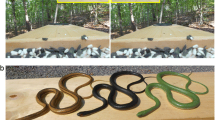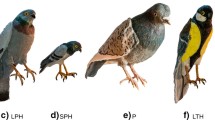Abstract
Accurate recognition of a predator is the necessary precondition for adequate antipredatory behaviour. We used feeder experiments to examine whether birds adopt the appropriate antipredatory response according to the level of threat posed by predators. The results support the idea that the tits made a decision on the threat level. The tits distinguished among equally sized obligatory predators (sparrowhawk, kestrel), an occasional predator (jay) and a harmless bird of similar size (pigeon) and a smaller harmless bird (thrush). The presence of both birds of prey was associated with a considerable reduction in the number of feeder visits when compared with the harmless birds. The number of visits to the feeder that had a dummy jay positioned on it did not significantly differ for harmless birds or for predators. Different sizes of harmless birds did not influence the tits’ behaviour. The increasing risk lowered not only the number of visits to the feeder but also the success of the visit, pecking rate, and the direction of arrival to the feeder. Generally, birds assessed the risk during food searching, evaluated the situation, and adapted their behaviour accordingly.




Similar content being viewed by others
References
Arnold KE (2000) Group mobbing behavior and nest defence in a cooperatively breeding Australian bird. Ethology 106(5):385–393
Brittingham MC, Temple SA (1988) Impacts of supplemental feeding on survival rates of black-capped chickadees. Ecology 69:581–589
Buitron D (1983) Variability in the responses of Black-billed Magpies to natural predators. Behaviour 87(3–4):209–235. doi:10.1163/156853983X00435
Caro TM (2005) Antipredator defenses in birds and mammals. The University of Chicago Press, London
Carrascal LM, Alonso CL (2006) Habitat use under latent predation risk. A case study with wintering forest birds. Oikos 112:51–62
Carrascal ML, Polo V (1999) Coal tit, Parus ater, lose weight in response to chases by predators. Anim Behav 58:281–285
Clemmons JR, Lambrechts MM (1992) The waving display and other nest site antipredator behavior of the black-capped chickadee. Wilson Bull 104(4):749–756
Cockrem JF, Silverin B (2002) Sight of a predator can stimulate a corticosterone response in the great tit (Parus major). Gen Comp Endocrinol 125(2):248–255. doi:10.1006/gcen.2001.7749
Cresswell W, Butler S, Whittingham MJ, Quinn JL (2009) Very short delays prior to escape from potential predators may function efficiently as adaptive risk-assessment periods. Behaviour 146:795–813
Curio E, Klump G, Regelmann K (1983) An anti-predator response in the great tit (Parus major): is it turned to predator risk? Oecologia 60:83–88
Desrochers A, Belisle M, Bourque J (2002) Do mobbing calls affect the perception of predation risk by forest birds? Anim Behav 64:709–714. doi:10.1006/anbe.2002.4013
Devereux CL, Whittingham MJ, Fernández-Juricic E, Vickery JA, Krebs JR (2006) Predator detection and avoidance by starlings under differing scenarios of predation risk. Behav Ecol 17(2):303–309. doi:10.1093/beheco/arj032
Edelaar P, Wright J (2006) Potential prey make excellent ornithologists: adaptive, flexible responses towards avian predation threat by Arabian babblers Turdoides squamiceps living at a migratory hotspot. Ibis 148:664–671. doi:10.1111/j.1474-919X.2006.00567.x
Ehrlich PR, McLaughlin JF (1988) Scrub jay predation on starling and swallows-attack and interspecific defense. Condor 90(2):503–505
Ekman J (1989) Ecology of non-breeding social system of Parus. Wilson Bull 101:263–288
Forsman JT, Mönkkönen M, Inkeröinen J, Reunanen P (1998) Aggregate dispersion of birds after encountering a predator: experience evidence. J Avian Biol 29:44–48
Gentle LK, Gosler AG (2001) Fat reserves and perceived predation risk in the great tit, Parus major. Proc R Soc Lond B 268(1466):487–491. doi:10.1098/rspb.2000.1405
Ghalambor CK, Martin TE (2002) Comparative manipulation of predation risk in incubating birds reveals variability in the plasticity of responses. Behav Ecol 13(1):101–108
Götmark F (2002) Predation by sparrowhawks favours early breeding and small broods in great tits. Oecologia 130(1):25–32. doi:10.1007/s004420100769
Gottfried BM (1979) Anti-predator aggression in bird nesting in old field habitats-experimental analysis. Condor 81:251–257
Griesser M (2008) Referential calls signal predator behavior in a group-living bird species. Curr Biol 18:69–73. doi:10.1016/j.cub.2007.11.069
Griesser M (2009) Mobbing calls signal predator category in a kin group-living bird species. Proc R Soc Lond B 276:2887–2892. doi:10.1098/rspb.2009.0551
Hothorn T, Bretz F, Westfall P (2008) Simultaneous inference in general parametric models. Biom J 50(3):346–363
Jacobsen OW, Ugelvik M (1992) Antipredator behavior of breeding Eurasian wigeon. J Field Ornithol 63(3):324–330
Kaby U, Lind J (2003) What limits predator detection in blue tits (Parus caeruleus): posture, task or orientation? Behav Ecol Sociobiol 54(6):534–538. doi:10.1007/s00265-003-0665-5
Kleindorfer S, Fessl B, Hoi H (2005) Avian nest defence behaviour: assessment in relation to predator distance and type, and nest height. Anim Behav 69:307–313. doi:10.1016/j.anbehav.2004.06.003
Knight RL, Temple SA (1986) Nest defense in the American goldfinch. Anim Behav 34:887–897. doi:10.1016/S0003-3472(86)80075-6
Knight RL, Temple SA (1988) Nest-defense behavior in the red-winged blackbird. Condor 90:193–200
Krams I, Krama T (2002) Interspecific reciprocity explains mobbing behaviour of the breeding chaffinches. Fringilla coelebs. Proc R Soc Lond B 269(1507):2345–2350. doi:10.1098/rspb.2002.2155
Kubler S, Kupko S, Zeller U (2005) The kestrel (Falco tinnunculus L.) in Berlin: investigation of breeding biology and feeding ecology. J Ornithol 146(3):271–278. doi:10.1007/s10336-005-0089-2
Lilliendahl K (1997) The effect of predator presence on body mass in captive greenfinches. Anim Behav 53:75–81. doi:10.1006/anbe.1996.0279
Lilliendahl K (1998) Yellowhammers get fatter in the presence of a predator. Anim Behav 55:1335–1340. doi:10.1006/anbe.1996.0279
Lilliendahl K (2000) Daily accumulation of body reserves under increased predation risk in captive greenfinches Carduelis chloris. Ibis 142(4):587–595
Lind J, Jongren F, Nilsson J et al (2005) Information, predation risk and foraging decisions during mobbing in great tits Parus major. Ornis Fenn 82(3):89–96
MacLeod R, Gosler AG (2006) Capture and mass change: perceived predation risk or interrupted foraging? Anim Behav 71:1081–1087. doi:10.1016/j.anbehav.2005.07.022
Palleroni A, Hauser M, Marler P (2005) Do responses of galliform birds vary adaptively with predator size? Anim Cogn 8:200–210
Patterson TL, Petrinovich L, James DK (1980) Reproductive value and appropriateness of response to predators by white-crowned sparrows. Behav Ecol Sociobiol 7(3):227–231
Pravosudov VV, Grubb TC (1998) Management of fat reserves in tufted titmice Baelophus bicolor in relation to risk of predation. Anim Behav 56:49–54. doi:10.1006/anbe.1998.0739
R DEVELOPMENT CORE TEAM (2008) r: a language and environment for statistical computing. R Foundation for Statistical Computing, Vienna, Austria. ISBN 3-900051-07-0. http://www.R-project.org
Reyer HU, Fischer W, Steck P et al (1998) Sex-specific nest defense in house sparrows (Passer domesticus) varies with badge size of males. Behav Ecol Sociobiol 42(2):93–99
Rytkönen S, Soppela M (1995) Vicinity of sparrowhawk nest affects willow tit nest defense. Condor 97:1074–1078
Rytkönen S, Kuokkanen P, Hukkanen M et al (1998) Prey selection by Sparrowhawks Accipiter nisus and characteristics of vulnerable prey. Ornis Fenn 75(2):77–87
Schmidt KA, Whelan CJ (1999) Nest placement and mortality: is nest predation a random event in space and time? Condor 101:916–920
Shields WM (1984) Barn swallow mobbing: self-defense, collateral kin defense, group defense, or parental care? Anim Behav 32:132–148
StatSoft (2007) STATISTICA, version 8.0. http://www.statsoft.com
Templeton CN, Greene E, Davis K (2005) Allometry of alarm calls: black-capped chickadees encode information about predator size. Science 308:1934–1937. doi:10.1126/science.1108841
van der Veen IT (1999) Effects of predation risk on diurnal mass dynamics and foraging routines of yellowhammers (Emberiza citrinella). Behav Ecol 10(5):545–551. doi:10.1007/BF00299368
Walther BA, Gosler AG (2001) The effects of food availability and distance to protective cover on the winter foraging behaviour of tits (Aves: Parus). Oecologia 129:312–320
Acknowledgments
We are grateful to the anonymous reviewers for their truly helpful comments that have driven us to review once again. I am also grateful to Philip Butterill and Legi Sam for their comments, and support during my work on manuscript. The study was financially supported by grants of the Academy of Sciences of the Czech Republic (IAA601410803), and the Ministry of Education, Youth, and Sports (MSM6007665801).
Author information
Authors and Affiliations
Corresponding author
About this article
Cite this article
Tvardíková, K., Fuchs, R. Tits recognize the potential dangers of predators and harmless birds in feeder experiments. J Ethol 30, 157–165 (2012). https://doi.org/10.1007/s10164-011-0310-0
Received:
Accepted:
Published:
Issue Date:
DOI: https://doi.org/10.1007/s10164-011-0310-0




